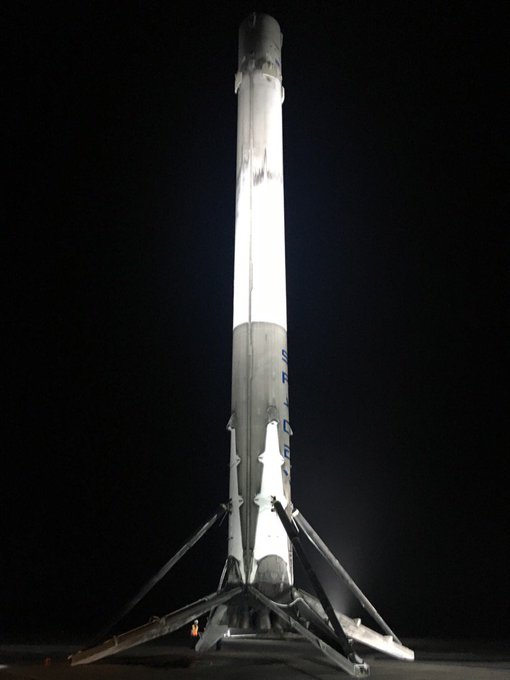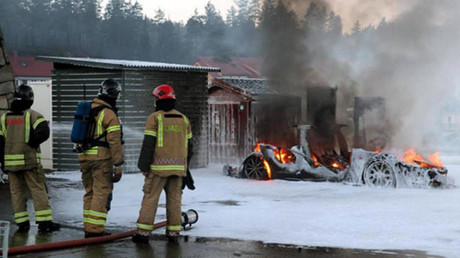As reported by CBSNews: A SpaceX Falcon 9 rocket roared to life and streaked into space early Monday, boosting a Dragon cargo ship into orbit loaded with nearly 5,000 pounds of equipment and supplies bound for the International Space Station, including a critical docking mechanism needed by U.S. crew capsules now under construction.
 The MinION gene sequencer works by measuring very slight changes in electrical conductivity as DNA components pass through a biological pore. Rubins said the research she hopes to carry out will help scientists better understand the mechanisms behind bone loss, muscle atrophy and other negative aspects of living in microgravity.
The MinION gene sequencer works by measuring very slight changes in electrical conductivity as DNA components pass through a biological pore. Rubins said the research she hopes to carry out will help scientists better understand the mechanisms behind bone loss, muscle atrophy and other negative aspects of living in microgravity.
SpaceX also pulled off its fifth first-stage landing and its second touchdown at the Cape Canaveral Air Force Station. Recovering, refurbishing and eventually re-launching Falcon 9 stages is a key element in company founder Elon Musk's ongoing attempt to dramatically lower the cost of spaceflight.
Musk tweeted about it:
But the first-stage recovery Monday was a purely secondary objective.
The mission's primary goal was to boost the SpaceX Dragon cargo ship into orbit and along with it, the long-awaited International Docking Adapter, or IDA.
The half-ton Boeing-built component will replace one that was destroyed in a June 2015 Falcon 9 launch failure and keep NASA on track for initial test flights of the new crew ferry ships in 2017 or 2018.
Also on board the Dragon: 815 pounds of food, clothing and other crew supplies, 280 pounds of spacewalk equipment, 119 pounds of Russian hardware, 617 pounds of U.S. station equipment and spare parts and a full ton of research samples and equipment, including an innovative device the size of a small candy bar to carry out the first gene sequencing in space.
"We're really interested in how this works in microgravity; it's never been done before," said astronaut Kate Rubins, a molecular biologist launched to the space station July 6. "We're going to be trying to do the first DNA sequencing in space, and it'll be a combination of a bacteria, a virus and a mouse genome that we'll be sequencing."
 The MinION gene sequencer works by measuring very slight changes in electrical conductivity as DNA components pass through a biological pore. Rubins said the research she hopes to carry out will help scientists better understand the mechanisms behind bone loss, muscle atrophy and other negative aspects of living in microgravity.
The MinION gene sequencer works by measuring very slight changes in electrical conductivity as DNA components pass through a biological pore. Rubins said the research she hopes to carry out will help scientists better understand the mechanisms behind bone loss, muscle atrophy and other negative aspects of living in microgravity.
"It also has a benefit for Earth-based research as well," she said. "When we do things in a remote environment up here, we can understand how these technologies might work in remote places on Earth that don't have access to good medical care," Rubins said.
Other experiments of interest aboard the Dragon include a study to determine the effects of weightlessness on microorganisms that originated in the Chernobyl nuclear disaster; a study to learn how beating heart cells are affected by weightlessness; tests of an experimental ship tracking system; and another to evaluate a new type of heat exchanger to control spacecraft temperatures.
Also on board: 12 mice that will be returned to Earth aboard the Dragon in late August. The rodents will be studied after the flight to determine how they were affected by exposure to weightlessness.
"This research cargo will support over 280 experiments," said Camille Alleyne, a space station program scientist at the Johnson Space Center in Houston. "These are in a variety of disciplines, including human research, biology and biotechnology, physical sciences, Earth and space sciences, technology demonstration and education."
The latter category includes a cache of tomato seeds that will be distributed to school kids after the flight to find out what effects, if any, might be due to time spent in weightlessness.
Putting on a dramatic overnight sky show under a nearly-full moon, the 20-story tall Falcon 9's nine first stage engines ignited with a torrent of fiery exhaust at 12:45 a.m. EDT, boosting the rocket away from pad 40 at the Cape Canaveral Air Force Station.
Liftoff came just 31 hours after launch of a Russian Progress supply ship from the Baikonur Cosmodrome in Kazakhstan that is carrying 5,800 pounds of supplies and equipment. If all goes well, the Progress MS-03/64P supply ship will reach the station Monday evening, docking at the Earth-facing Pirs module around 8:22 p.m.
The 229-foot-tall Falcon 9, generating 1.5 million pounds of thrust, initially climbed straight up from launch complex 40 and then arced away to the northeast as it thundered directly into the plane of the space station's orbit.
Spectators, including VIPs and the media, were forced to leave the nearby Kennedy Space Center an hour before liftoff because of recent modifications designed to enable the Dragon's landing parachutes to deploy in the event of a mishap that might leave the capsule -- and its valuable cargo -- intact after a booster failure.
Because forecasters predicted winds that could blow a descending capsule back toward the launch site after an in-flight accident, Air Force range safety officers ordered non-essential personnel to leave the area in case of a landing that could result in the release of toxic propellants.
But the climb away from the Cape was picture perfect. The first-stage engines burned for two minutes and 21 seconds, propelling the rocket out of the dense lower atmosphere before shutting down. A moment later, the first stage fell away and the single engine powering the second stage ignited to continue boosting the Dragon toward orbit.
The first stage, meanwhile, flipped around tail first and carried out the first of three engine firings to halt its forward velocity and begin the flight back to a landing at the Cape Canaveral Air Force Station.
Four minutes later, three of the first-stage engines re-ignited to slow the ship for descent back into the discernible atmosphere. Then, about seven-and-a-half minutes after launch, the engines fired back up a third time for landing.
Spectators in nearby Port Canaveral were treated to a spectacular show as the stage descended through a clear night sky atop a jet of fiery exhaust, deploying four landing legs and settling to a smooth touchdown on a pad known as Landing Zone 1. The landing was heralded by two sonic booms that rumbled across the Space Coast.
Going into the mission, SpaceX had made 9 attempts to land a Falcon 9 first stage, chalking up four successes: three on an off-shore "drone ship" and one at the Air Force station last December. The record now stands at five successes in 10 attempts. If all goes well, SpaceX hopes to re-launch its first used booster this fall.
While the first stage was flying back to Florida, the Falcon 9's second stage was boosting the Dragon toward space. Finally, about nine minutes and 37 seconds after liftoff, the Dragon separated from the second stage. A few minutes after that, two solar arrays unfolded and locked in place.
If all goes well, the Dragon will carry out a computer-controlled rendezvous, approaching the station from below early Wednesday. Expedition 48 commander Jeff Williams, operating the lab's robot arm, plans to latch onto the Dragon around 7 a.m. Flight controllers in Houston then will take over arm operations, moving the cargo ship into position for berthing at the forward Harmony module's Earth-facing port.




















